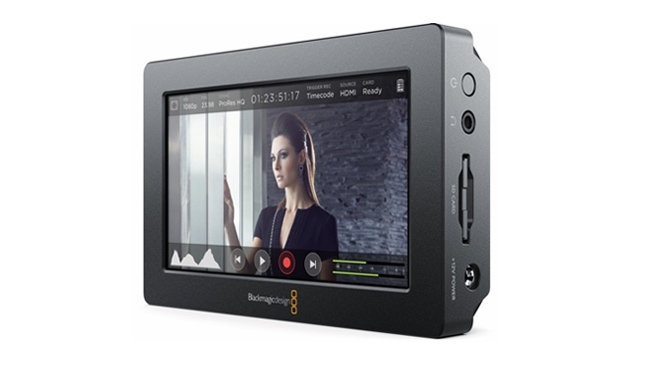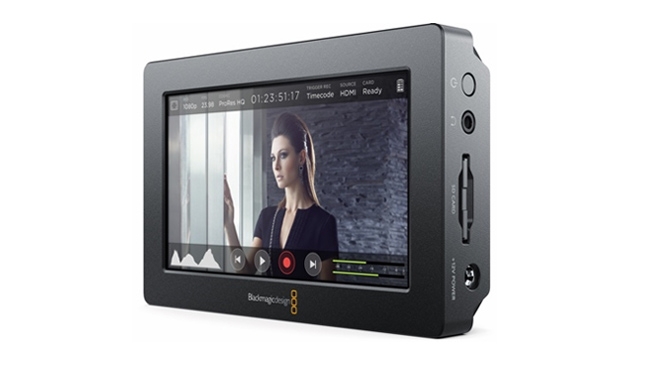
 The new £325 Blackmagic Video Assist
The new £325 Blackmagic Video Assist
Simon Wyndham spends time with the new $495 Blackmagic Video Assist and finds a unit that will appeal to people who are on a budget but still require a high quality, versatile monitor with good recording capabilities.
If you are in the market for an external viewfinder or camera mounted monitor, now is a good time to make a purchase, with more and more choice being available. Hot on the heels of the new SmallHD range of monitors comes the Blackmagic Video Assist, a lower cost 5” alternative to the more pricey offerings out there. But can it cut the mustard in terms of overall features and practicality?
Build Quality
Those who know me are in no doubt as to my views on Blackmagic products. They are incredibly well built, reliable, and affordable. Even if they put the prices up tomorrow, they would still be good value, and the picture put out by their cameras contain qualities that are lovely to behold.
On first handling the Video Assist monitor it is apparent that nothing has changed. Made from a black anodised machined aluminium body, the Video Assist has a nice weight to it. There is no doubting the construction quality.
Adorning the the left side you will find 6G SDI in/out, and full size HDMI in/out. While on the right hand side there is an SD slot for footage storage, headphones out, the power switch, and a 12v in port. Both the top and bottom of the device allow for a total of size screw holes for various mounting options. The bottom also contains a USB port, utilised for firmware upgrades. As a neat little feature there is also a flip out stand to allow the Video Assist to free stand on a table top or other flat surface.
Portable power is taken care of by two Canon E6 battery mounts. The battery system, to quote BMD, uses a serial discharge, with the battery containing the least power being depleted first. Connecting the Video Assist to a 12v power supply also charges the batteries in parallel.
Video sampling is in 4:2:2 YUV 10-bit colour, and the device supports SDI metadata including closed captioning. When recording in ProRes formats the Video Assist supports up to 16 channels of audio for SDI Audio Output, while Avid DNxHD is restricted to 2 channels.
Video Assist in use
My first impression of the display in use was that it was very clear and defined. The Video Assist is a native 1920x1080 display, and being a 5” monitor offers a very similar pixel density as a result to the SmallHD 502. This not only makes it nice, crisp, and sharp, but makes the on screen fonts very easy to read, too.
The monitor displays a very responsive histogram, audio metering, battery level information, recording format and frame rate, as well as timecode. A simple tap on a magnifying glass icon allows digital zooming for ensuring focus.
The latest firmware contains guides for various screen ratios, as well as focus peaking. The latter being of the coloured type, which in all honesty I have never found truly useful because it only seems to appear on the very highest frequency edges. This is less help in focussing on more subtle detail (though this isn’t specific to the Video Assist; it’s a problem with many cameras). Lastly there are adjustable zebra highlight options.
To avoid screen clutter a simple swipe up or down the screen with your finger is all that is needed to move all that information out of the way. A swipe up or down again will bring it back again.
The Video Assist can be set to have its recording triggered in two ways, via a trigger record over SDI or T/C Run, which detects running timecode over either SDI or HDMI and starts and stops recording accordingly.
Playback of clips is nice and easy, and scrubbing through them using the touch screen is a simple using the scrubbing slider.
One nice touch regarding the power monitoring is that a click on the battery icon brings up a screen size icon with a very accurate representation of how much power is left in each of your E6 batteries. Power consumption appeared very good, and while your mileage may vary, with my fairly well used E6s I was getting around 2hrs continuous runtime.
Cooling is taken care of with a fan, which I have to say can be audible, so you may need to take care when recording in quiet environments.
The Video Assist records to SD cards rather than CFast as per their higher end cameras. This means that although it can accept a 4K signal, it is strictly an HD recorder, capable of up to 1080p at 60fps. The use of SD cards means that those who are hoping for 4K recording via firmware later on will need to be aware that this will not be possible. So, while you may not be able to record 4K if you own a 4K camera, you will be able to record high quality HD proxies, or as a straight backup for a 1080p camera, and nailing your focus.
For DSLR owners who own a camera with a clean HDMI out, the Video Assist will allow them to record and monitor footage in a higher quality fashion than they would using the internal recording. The Video Assist will also act as a great way to monitor footage from the BMD Micro Cinema Camera too.
Another thing to note is that Avid DNxHD was not available as a recording codec in the firmware I tested (v1.1).
Taking it outside
Outdoors the usual limitations apply, and some sort of shade will be required, although the wide viewing angle is very good indeed. The menu system is operated via touching the screen, and it is here that the SmallHD 500 series takes a bit of a lead. While the Video Assist menus are easy to navigate with simple swipe gestures and presses on relevant parts of the screen, those fingermarks will soon take their oily toll. Viewed head on and they won’t be a problem, but depending on the scene lighting used anything off angle may show the ugliness of your skin oils!
I have one other issue with the Video Assist, too. If you like to set your monitors up to colour bars, the Video Assist won’t, well, assist you much. Whilst it is a simple thing to output bars to it (presuming you have some pre-recorded onto a card or your camera can output them — it would be nice if BMD cameras would have bars built in) it is quite hard to adjust the screen to them. This is because the brightness, contrast, and saturation adjustment sliders are featured on top of a semi translucent dark background.
Thus to make an adjustment requires making a change, then exiting the menu to check the result, and then going back to the adjustment screen again. As a result it will be difficult to get any consistency across screens, and what you see on the Video Assist can only really be an approximation of the picture. A very good one mind, but be aware of the limitations. Of course there is more to setting up a screen truly accurately than this, but it would be nice to get some sort of technical gauge when required.
There are no options for loading LUTs either, not even built in correction for BMD cameras film modes. This might perhaps be something that is added in firmware at a later date, and very welcome it would be too.
But let us not get carried away. The BMD Video Assist retails at $495/£350. That’s less than half of what you’d pay for the SmallHD 502, which doesn’t offer recording abilities.
Conclusions
When assessing the Blackmagic Video Assist we need to take account of what it is, rather than what it isn’t. It may appear that I have been harsh in my mentioning of its limitations, but I feel it important that you do not view this as a feature for feature alternative to higher end alternatives such as the Odyssey7Q monitor/recorder for instance.
The Video Assist will appeal to people who are on a budget, but still require high quality, versatile monitor with good recording capabilities. As a monitor it doesn’t have all the bells and whistles of more pricey products such as the SmallHD 502, but we should also remember that like for like the 502 does not have any recording capabilities. And who knows what BMD will add via firmware at later dates? If a LUT capability was added then rivals will have something to be very concerned about.
What we have then is a high quality display in a robust casing and good connectivity that will easily stand up to the rigours of day to day production at a price that won’t break the bank, with Blackmagic’s superb build quality and robustness.
Tags: Production



Comments